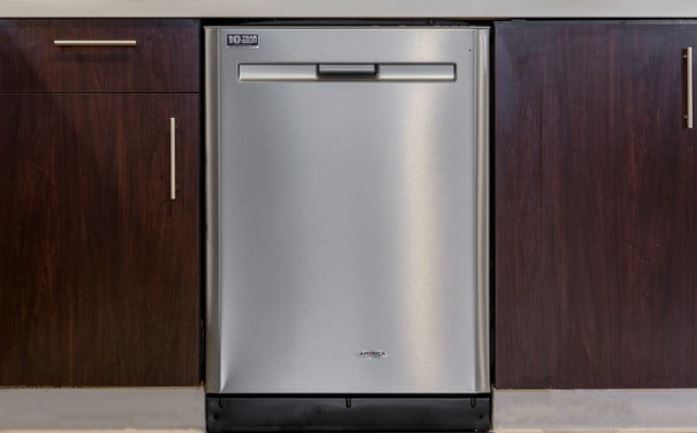Is washing cookware and utensils a chore you procrastinate forever? It is about time you invested in a dishwasher.
A dishwasher is a machine used for washing dishes. It works by spraying hot water on the plates. It adds detergent to this water. The dishes are then sprayed with clean water to remove residues. The whole process is automated and therefore can use strong detergents. Josephine Cochrane, a wealthy woman of this type, is credited with the invention of the dishwasher.
Dishwashers come in standard sizes and can be installed in kitchen cabinets. On average, dishwashers use 6 gallons of water per cycle. Economical ones with the Energy Star certification may use as low as 4 gallons of water per cycle. They are classified as laundry per hour. Let’s now take a closer look at the dishwasher cleaning compartment.
A typical dishwasher is equipped with a plastic or stainless steel covered bath. It is believed that the latter is more resistant to hardness and provides the best quality conditioner. Some dishwashers have garbage disposal devices. These units help collect food waste. However, before loading them into the dishwasher, it is recommended to empty the dishes from the food contents.
Dishwashers available on the market today have a processor with minimal wash cycles. This helps the dishwasher adjust the washing time according to the amount of dirt in the rinse water. The dishwasher has an internal sense of this element.

A typical dishwasher sends water from the bottom up through the cone-shaped structure to the upper wash room to spray water on the above-mentioned dish rack. Some models have a tube attached to a holder that connects to a water source. This basic principle underlies the operation of each dishwasher.
Many modern dishwashers benefit from blankets, panels and other sound-absorbing materials that dampen sound up to 44 decibels. Biodegradable detergents can be used instead of conventional detergents for dishwashers. Sometimes the ingredients of some soaps can cause “cleaning” of glassware, making it look cloudy.
Do not load plastic, silver, aluminum or lead objects into the dishwasher, as they may damage the dishwasher. You can only use ordinary household items such as plastic, dishes, cups, and cups.
Once considered a first-class dishwasher, dishwashers are available today for any budget. They are a blessing for busy homemakers because they take on an unpleasant burden. Many dishwashers are available in the market. There are portable dishwashers, built-in models (can be neatly installed in kitchen cabinets) and countertops. Choosing the right dishwasher for your family and unique needs can save you time and energy, which are invaluable and seem to be in such small quantities.
Here are some tips on how to use a dishwasher economically.
- Loading dishes or utensils properly is an essential aspect of using the appliance well. You should pack them in such a manner that the spray of water reaches the dirtier side adequately. It also helps to observe the design of the dishwasher and make sure the most soiled utensils are placed closer to the center of the appliance.
- When you load the appliance, take out large food items such as peels or bones.
- You may or may not be required to rinse the appliance before it is loaded. In some modern-day machines, you may not need to clean beforehand; you may need to carry out some trials before you understand if you need to rinse the pitchers.
- You should place plates in the spaces at the bottom part of the machine. The bowls, cups or glasses could go against the upper portion. If they are positioned at a slight angle, the detergent/cleaning solution can easily reach the inside of the vessels.
- Don’t place plastic-ware on the bottom portion because the heat could change the shape of such items.
- Take care not to overload your appliance. Don’t place cutlery such as long-handled spoons in the cutlery space, and instead, keep them in the upper portion. The reason is that the long items can come in the way of the proper functioning of tubes or nozzles.
Additional Tips for Sustainable Dishwasher Use
Whether your dishwasher is brand new or old as far as ten years, here are some modest steps you can take in cleaning your dishes more efficiently and effectively. After that, these simple tests will not only reduce physical stress on the dishwasher, prolonging your life but also reducing your utility bills where power and water will be used in a controlled manner.
Seven tips for cleaning the dishes extra effectively in the dishwasher
- Check the arm sprayer. Make sure that the objects that swing inside the dishwasher do not hinder the arm sprayer. You should be ready to rotate it manually, while not touching any obstacles such as long-serving utensils or dishes. Be sure to check the sprayer holes also, using the bar to release any dust may have been inserted.
- Check the migration. Check down from the bottom of the dishwasher before use once. You will get clogged in the lowest with food and alternative dust. Clean the filter frequently and run garbage disposal later because it shares an equivalent drainage line in most cases.
- Check the drainage line. The drainage line is usually a plastic tube that is connected to the lure in the sink or kitchen appliance. This tube will be blocked, preventing proper discharge. Check the drain line often for obstacles.
- Do not make the detergent complete. The detergent cups unit asked for measurements and generally wrote a full load in a relevant course. You do not have to continually force you to fill it up. Check out the guide that came with your dishwasher for proper detergent measurements. If you look closely, you’ll probably see some lines that indicate where hundreds should be crammed. An excessive amount of detergents leave residue on dishes that cause you sickness.
- Consider the water temperature. A real sign that your water may be forced to be hotter is once it takes time for the last water to succeed in your aquarium. This indicates that your dishwasher has a more stringent cleaning of food and grease. Try running the dishwasher once you run fresh water inside the aquarium for several minutes. You will also be able to think about isolating your impasse tubes if they are not already. Another difference appears in the water temperature directly in the heater or room. If your heater is away from your room, you will invest in a small portable heater.
- Clean inside your dishwasher. It is important to keep inside your dishwasher clean for perfect cleaning conditions. Residues from detergents, grease, food particles and deposits from Card Caen are easily collected while improper use and care. Every few months or so, your dishwasher must be run through a full cycle as soon as it is empty. Do not use detergents, but only hire the machine to last several minutes until the aquarium starts to fill the water at the lowest level. Then, add 2 cups of white vinegar to the water and allow the cycle to run its course usually.
- Water maintenance. If you have got water in your own space, there is likely to be additional building for KA and alternative deposits. For this, you will most likely want to stimulate more depth with your cleaning routine. If you are in position, take the spray arm and other internal components out into the CLR (calcium, lemon and rust remover). CLR is explicitly designed to eliminate the types of problems caused by hard water.
Advanced Technology in Dishwashers.
There are hundreds of brands, models, and sizes of dishwashers that are introduced in modern markets in response to unprecedented hardware demands. Dishwashers offer great comfort to homemakers from the tidy stack of many dirty hand washing dishes. Like all other devices, many changes have also been made to their old form and content. The original raw machinery was replaced by modern technological wonders. The process of transformation has been progressive for over 50 years. The changes were inevitable as user requirements also changed. The volume, shape, and number of household appliances underwent substantial changes, and therefore dishwashers needed a shift accordingly. The machines were updated periodically by consumer requirements.
There are two dishwashers today, two stand-alone and compact categories. Small portable units are also available but may not have as many special features as large items. Place preparation is the term to indicate the dishwasher capacity. It is a vague term used in world markets. The preparation of one place is the space needed to accommodate one dinner dish, one soap dish, one dessert, one glass cup, one cup of tea, one dish and a set of knife, fork, and spoon. Different sizes of dishwashers are from 4 to 15 settings for the place. As mentioned above, the sizes of dishes and dishes vary, so the capacity as specified in the settings of the place may not be very accurate. For practical purposes, shoppers choose dishwashers based on length, width, and height of tools. To explain this aspect, it can be said that a small family consisting of two or three individuals can handle an 18-inch dishwasher, which is equivalent to roughly 6 to 8 standard settings for the place.
The principle of the machine is to spray hot water on dirty dishes that use pressure. Jets of hot water will be sprayed from different directions. Detergents are also used in this process. Water and energy consumption are the factors that must be taken into consideration when considering the economic feasibility of a dishwasher. Water must be changed during successive cycles as water quality deteriorates. Power is used to heat water and to operate the machine. The consumer should be interested in choosing the dishwasher using the right power card, to minimize operating costs. Modern machines have been integrated with new techniques to reduce water consumption. Environmental experts warn that both energy and water will become scarce and expensive resources shortly.
Convenient stacking arrangements, programming, and electronic work are some of the characteristics of modern dishwashers. They feature easy-to-use control panels, LCD screens, float switches, detergent dispensers, etc. Sensors are provided to monitor water quality during washing and change them automatically. Timers will indicate the time required to complete the operation. The air and water temperature will also be monitored. Noise levels in modern machines are within reasonable limits.
Consumers should be interested in maintaining the machine to enhance its durability. Regular cleaning after daily use is essential. Residual food particles that may stick to the interior of the dishwasher will cause health risks if cleaning is neglected.
Take Care of Your Dishwasher
Dishwashers are one of the valuable creations intended for cleaning dishes. Does it need to be cleaned too? This should also be removed. If left untouched, debris can accumulate and can reduce the performance of your dishwasher. However, he does not need the usual cleaning. Here are some simple tips on how to keep dishwasher clean.
Use it regularly. Never run your dishwashers even once in a blue moon. Regular use of your dishwasher prevents debris from entering it.
Check rotating hands from time to time. Ensure all openings are open so that water can circulate freely in the spray arms. Sometimes impurities from the water can become clogged on the holes. Even some food particles can stick to the spray arm and prevent water from splashing. You can use any sharp tool, such as a sharp needle or a toothpick, to remove debris. You can handle many ways to remove trash. Since piercing holes with a sharp needle is a painstaking process, you can also use a flexible metal brush.
Clean your dishwasher’s dead space (place under the bottom of the door) where water never reaches. Wipe with a damp cloth.
Check the bottom of your dishwasher near the drain hole. This is where the water is drained after each wash cycle. Make sure that there is no littering in this area. You can avoid clogging by carefully loading the dishes after disposing of products. If you are stuck between the wash cycles, you need to disassemble it to make it work again.
When disassembling a dishwasher, you need to make sure of the following.
- Carefully remove the screws. If you have a digital camera, take a picture to make sure that the screws are correctly positioned.
- Seal the hole to prevent debris from entering during the cleaning process.
- Always use gloves to remove solid debris, as it may contain sharp objects that may damage your fingers.
- You can use a brush to remove blockages.
- Replace the screws and never tighten them too much, as this may damage the equipment.
How to remove the resulting scales?
For many people, using hard water for washing dishes is a difficult task due to the formation of scale. This can create many obstacles to a clean wash cycle. A mild acid wash can reduce salt deposits. You can try lemonade or vinegar for a mild wash.
- Using bleach can harm both your hand and your dishwasher. You can dilute with plenty of water.
- To remove rust, you can use a rust remover that is suitable for washing in a dishwasher.
- It is always recommended to replenish the rinse aid dispenser in the dishwasher once a month. Depending on the chemical composition of the water, it is advisable to choose a rinse aid substitute, such as “white vinegar.
- Never use a softener and rinse aid together.
- Detergents with an integrated rinse aid are currently available on the market.
- Eco-friendly liquid detergents are abundant in the market. Using such detergents can benefit both your dishwasher and your dishes.
- Do not use detergents that contain excess phosphate
- If you take care of your dishwasher, you can enjoy the durability of the product. You can also refer to your User Guide to maximize the security of your smart thing. However, the safe operation of any machine requires additional attention from users.
Save time. These social researchers were busy again, apparently, if you wash the dishes in the machine, not manually, you can save up to three weeks a year.
Wash more healthy. This time saving is now likely to be reserved for a family of 12 people. But experts also believe that dishwashers are healthier than handwashing. This is because the water temperature is much higher than carrying your hands, washing your brushes and your sponge is an excellent breeding ground for germsTips for using the dishwasher
If you are concerned about the amount of dishwasher consumption, a new generation of energy-saving machines can attract you – especially if you remember that it needs to be packaged wisely and operated only when it is full.
But resist the temptation to use the dishwasher at low temperatures to save money. To break the board effectively, you should usually turn the machine on in hot wash mode – the most economical settings do not seem to ruin the tablet completely.
Is any detergent better?
Well, now they are sorted, but what kind of dishwasher cleaner should you use – tablets, liquids, or powders?
Many people, including myself, prefer tablets because they are very comfortable. But liquids and especially powders are much cheaper. As for tablets, Final Power Ball discs (manufactured in the range of about 4.50 lbs to 30) have proven themselves in consumer tests, but they are too expensive. The cost of the Tesco tablets (currently £ 1.72 versus 30) and the Lidl W5 tablets, which added a siphon and a water purifier (currently £ 3.99 to $ 40), also performed well on tests cheaper. But not all cheap brands are worth the trouble. Morrisons and Asda brands do not fit well in consumer reviews, so leave them alone.
Cheaper, greenwash
If you want to save money, some people swear to use only half a disk per wash cycle. I tried it with the Power Finish Classic discs, and it seems quite reasonable. Other people swear by using traditional washing powders (biological or non-washing), although I have not tried it yet.
For a green alternative, try the Eco cover tablets. They are cheaper than many Finish discs, and although I do not think they work well, they do perform a very reasonable job and at least will not harm the environment. You may also want to try Clearspring Dishwashing Gel (which does not make tablets), which got good reviews on consumer sites, and about £ 4 per liter, looks good quality. They are available at some health food stores and online.
Do I need to add salt?
Even if dishwasher tablets contain salt, most dishwashers and manufacturers recommend adding them, especially if you live in a stable water area. However, dish salt is inexpensive and will not need to be refilled too much.
Clean and update your dishwas her.
To get rid of the dirt that accumulates in the dishwashers, clean the appliance almost every month. You do not need to buy expensive specialty products for this purpose. Just pour a glass of white vinegar on the bottom of the machine and start in the maximum settings. That’s all the work done.






